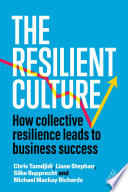

Resilience in organizational culture refers to the ability of an organization to adapt to challenges, recover from setbacks, and thrive in the face of adversity. The book emphasizes that resilience is not merely about bouncing back but involves a proactive approach to change and disruption. Leaders are encouraged to foster a culture that embraces flexibility, innovation, and a growth mindset. This involves creating an environment where employees feel safe to express their ideas, take risks, and learn from failures. By doing so, organizations can better navigate uncertainties and maintain their competitive edge.
Continue readingLeadership plays a crucial role in shaping a resilient culture. The book illustrates that leaders must model resilience themselves and communicate a clear vision that inspires their teams. Effective leaders cultivate trust and transparency, allowing employees to feel secure in their roles. They also encourage collaboration and inclusivity, which fosters a sense of belonging and community. By empowering employees to take ownership of their work and encouraging open dialogue, leaders can create a resilient organization that can withstand challenges and emerge stronger.
Continue readingA growth mindset is essential for resilience. The book discusses how organizations can encourage a culture that embraces learning and continuous improvement. This involves providing opportunities for professional development, promoting innovation, and recognizing and rewarding effort and progress rather than just outcomes. By fostering a growth mindset, organizations can cultivate a workforce that is adaptable, creative, and willing to tackle challenges head-on. This approach not only enhances individual capabilities but also contributes to the overall resilience of the organization.
Continue readingPsychological safety is a critical component of a resilient culture. The book highlights that employees must feel safe to voice their opinions, share ideas, and admit mistakes without fear of retribution. Organizations that prioritize psychological safety create an environment where employees are more likely to take risks and innovate. The authors provide strategies for leaders to build psychological safety, such as encouraging open communication, actively listening to employee concerns, and fostering a non-judgmental atmosphere. When employees feel psychologically safe, they are more engaged and committed to the organization's success.
Continue readingDiversity and inclusion are vital for resilience. The book argues that diverse teams bring a wealth of perspectives, ideas, and problem-solving approaches that enhance an organization's ability to adapt to change. By embracing diversity, organizations can better understand and respond to the needs of their customers and stakeholders. The authors emphasize the importance of creating an inclusive culture where all voices are heard and valued. This not only boosts employee morale but also drives innovation and creativity, making the organization more resilient in the face of challenges.
Continue readingStrong relationships and networks within and outside the organization contribute significantly to resilience. The book discusses how organizations can foster collaboration and connection among employees, encouraging teamwork and mutual support. Additionally, building external networks with partners, customers, and industry peers can provide valuable resources and insights during times of crisis. The authors stress the importance of cultivating a culture of collaboration, where employees are encouraged to share knowledge and seek help when needed. This interconnectedness enhances the organization's ability to navigate challenges effectively.
Continue readingThe final key idea revolves around the necessity of continuous evaluation and adaptation. The book underscores that resilient organizations regularly assess their strategies, processes, and performance to identify areas for improvement. This involves gathering feedback from employees, analyzing data, and being open to change. The authors advocate for a proactive approach to resilience, where organizations anticipate potential challenges and develop contingency plans. By fostering a culture of continuous evaluation and adaptation, organizations can remain agile and responsive to evolving circumstances.
Continue reading